3 days in Marrakech: your ultimate Marrakech guide

By Emma Marshall and Nick Warburton
Marrakech is arguably Morocco’s most popular tourist destination.
And as you’ll find if you visit, 3 days in Marrakech will be 3 days of exploration in a city that blends centuries old traditions with contemporary, modern architecture, and fuses eastern and western influences with North African culture.
This post contains affiliate links
Why spend 3 days in Marrakech?
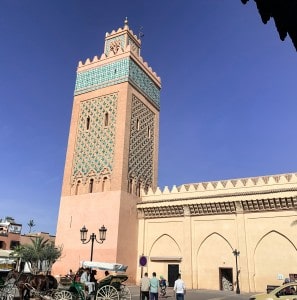
There’s so much to see and do in 3 days in Marrakech. A UNESCO World Heritage site, the walled medina offers a fascinating step back in time and is home to most of Marrakech’s main tourist spots.
This includes Jemaa El-Fna (a gigantic square home to street stalls, snake charmers and streets performers), the city’s souks and markets, as well as religious and cultural landmarks, including the Koutoubia Mosque.
You can also stay in one of the beautiful riads tucked away down the labyrinth of its narrow streets.
However, if you fancy it, you can still find some modernity in Marrakech. You can venture out of the city walls to the Gueliz district in Marrakech’s new town. Here you’ll feel you are visiting a different country altogether.
Representing the modern Morocco, visitors can shop in luxury outlets and dine out in style in fine restaurants.
Read on for information on this wonderful city, 22 of the best things to do in Marrakech, and for your ultimate Marrakech guide.
3 days in Marrakech: A brief history of the city
The Almoravids
Marrakech was founded in the late 11th century under the Almoravids and soon grew into a centre of cultural and religious importance. The Ben Youssef Mosque, the city’s oldest, dates from this very early period.
Almoravid emir Ali ibn Yusuf was the architect behind Marrakech’s distinctive red sandstone walls that surround the medina. These were built in the early 12th century to protect the royal family and its subjects from attack.
You can still see the impressive fortifications as you enter Marrakech’s medina quarter through a series of entrance gates.
When the Almoravids captured Marrakech in the mid-12th century, they began to reshape the city. They reorganised its layout, constructing many palaces and religious buildings. Most significant of these is the majestic Koutoubia Mosque.
The Saadian rule
After a period of decline, the 16th century saw the start of a renaissance in the city’s fortunes and the construction of many important buildings under Saadian rule. It also saw the development of the Jewish quarter (the Mellah).
The French
When the French arrived in the early 20th century, they put their own personal stamp on the city.
Stroll through the upmarket Gueliz district and you can spot the French influence through the colonial design of the buildings and the wide avenues.
Where is Marrakech?
With a population of nearly a million inhabitants, Marrakech is located in the mid-southwest of Morocco in Africa.
About 330km south west of Morocco’s capital, Rabat, and 240km south of Casablanca, Marrakech lies to the west of the Atlas Mountains. You can see these rising in the distance from the city.
The city is also 175km from Essaouira on the Atlantic coast.
Top facts about Marrakech
- Founded in the late 11th century, Marrakech is reportedly home to Morocco’s largest traditional market (souk).
- There are 18 souks, employing more than 40,000 people making a range of crafts.
- It is the country’s fourth largest city but is a mecca for tourists and home to many expats, particularly the French. It attracted nearly three million visitors in 2019.
- Marrakech is called the “Red City” thanks to the red sandstone that was used to construct the ramparts and the medina quarter.
- The medina (the part of the city surrounded by walls) is listed a UNESCO World Heritage site.
- Arabic is the official language although Berber and French are commonly spoken.
- Together with Fez, Meknes and Rabat, Marrakech is one of Morocco’s imperial cities.
- The Koutoubia Mosque is the city’s most distinctive landmark and its tallest building. Its name – Mosque of the Booksellers – is taken from the book stalls around the mosque.
- The tombs of Morocco’s seven patron saints are located in Marrakech and the city attracts many pilgrims.
- French fashion designer Yves Saint Laurent renovated the Majorelle Garden and his ashes were scattered here after he died in 2008.
Where to stay in Marrakech
If you want an authentic and unforgettable Moroccan experience, then the best area of the city to stay in is the medina in one of the beautifully preserved riads.
Properties that once belonged to wealthy families, many riads have been converted into boutique hotels and usually accommodate up to around 10 bedrooms. They are lavishly decorated and feature a main courtyard, which often include a garden or pool.
Most riads have a rooftop terrace where you’ll be served breakfast. You can also book an optional lunch and dinner. The latter is particularly useful if you are arriving late into the city.
We stayed in the Riad Andalla and had a fantastic time. Tucked away down a side street on the edge of the medina, its outside looked fairly nondescript.
But once inside, it’s a beautifully decorated historic building and a perfect place to cool off from the outside heat. It also has its own hammam that you can book in advance.

There are also a vast array of other riads that you can choose from – click here to browse these.
Alternatively, there are a number of modern hotels, located in the new town and on the fringes of the older part of the city.
There is also a selection of more luxury hotels, including the Hotel La Mamounia, the Mandarin Oriental, the Sofitel Marrakech Lounge & Spa and the Royal Mansour Marrakech.
See the more detailed section towards the end of our post for more ideas of where to stay in Marrakech. Or click here to browse a full selection.
Top things to do in 3 days in Marrakech
People often ask what can you do in 3 days in Marrakech? What are the best things to do in Marrakech?
Well, there are many different things you can see and do in 3 days in Marrakech and we can guarantee you won’t be bored!
Read on for more details of 22 of the best things to do in Marrakech.
And click here for details of tours that you will take you to the main sights of the city.
Experience the wonderful sights and sounds of the Jemaa el-Fna

This is probably Marrakech’s most popular tourist attraction. As the main square of the city, it is the beating heart of the medina. This vast open space pulls in huge crowds every day, drawn by its amazing sights, sounds and smells.
It’s hard to put into words the incredible atmosphere you experience as you walk through it.
I would recommend that you explore Jemaa el-Fna both during the day and at night to fully capture the essence of this captivating space.
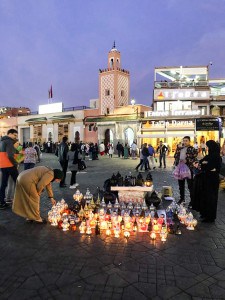
A word of warning however: keep your valuables safe as this is a popular area for pick pockets. Also mind the cars and motorbikes which zoom around the edges of the square.
Wander the stalls selling food and goods during the day and you will come across exotic sights like snake charmers and monkey trainers. There are also Moroccan musicians entertaining the crowds.
Jemaa el-Fna is also a good place to change currency if you’re there during the day.
At night, head for one of the rooftop bars lining the square. These provide a perfect vantage point to soak in the atmosphere, people watch and marvel at the colourful spectacle below.
The sheer numbers that pack into the square is really quite something.
As the light fades, the colours in the sky often turn a magical crimson and orange. Together with the call to prayer, it’s an experience you won’t forget in a hurry.
From some rooftops, you also get a bird’s eye view of the nearby Koutoubia Mosque. This is quite a sight as the sun sets and its dark silhouette stands out against the colourful sky.

Marvel at the Koutoubia Mosque
Built in the 12th century, Koutoubia is the largest mosque in Marrakech. It is also the most distinctive landmark on the city’s skyline (it’s the tallest building in the city).

Standing at 69 metres high, the minaret’s design was replicated by the Moors in Spain when they built the Giralda (the bell tower), which today forms part of Seville Cathedral.
Non-Muslims are not allowed to enter the mosque (or any mosque), but you can walk around it in the surrounding streets and the Koutoubia Gardens. This is a pleasant place to head for, especially as it’s not as crowded as the main square.

It is only a five-minute walk from Jemaa el-Fna and on the way you’ll pass Place Foucault. Here you can pick up a horse and carriage if you want a relaxing way to explore the city.

Explore the Bahia Palace with its spectacular Court of Honour
Marrakech is home to some beautiful palaces. But if you were to choose just one to visit, the Bahia Palace should be top of your list. Read my blog post on this major tourist site to find out more.
Dating from the mid-19th century, this royal palace underwent further expansion at the turn of the 20th century.
Not all of this historically significant building is open to the public. However, what you can see, including attractive patios, well tendered gardens and beautifully decorated rooms is worth every penny.
The highlight is undoubtedly the spectacular Court of Honour. Try and go at a quiet time to avoid the big tour groups.

From the Bahia Palace, you can also walk to Dar Si Said, El Badii Palace and the Saadian Tombs (near the Kasbah Mosque).
To visit the Bahia Palace, click here to purchase tickets.
Visit the El Badii Palace
Unlike the dazzling Bahia Palace, the El Badii is a ruin. However, you shouldn’t let this put you off visiting this historically important building.

Apparently, the sultan Ahmed al-Mansour built the palace in the late 16th century after beating the Portuguese in a decisive battle. Historians believe that the palace had more than 300 beautifully decorated rooms before it fell into decline.
Walk around the huge ruined courtyard as this will give you some sense of the scale of the palace. Some websites advise tourists to hire a local English-speaking guide who can provide more information about the ruins and the dungeons.
Tourists also come here to climb the walls. From these you are gifted excellent views of the city’s historic centre.
Check out these tours that include the El Badii Palace.
Grab a bargain in the souks

A visit to Marrakech would not be complete without a wander through its world famous souks. Go early in the morning if possible to experience the souks in full flow and watch the merchants haggling with tourists over prices. At this time, it will also be a little less crowded.
It’s definitely a place not to be missed during your 3 days in Marrakech. Apart from the motorbikes that weave their way around the pedestrians, you could be mistaken for thinking that you were stepping back in time to the 19th century.

Starting just north of Jemaa el-Fna, the markets cover a vast area.
They take in a labyrinth of narrow streets. These are full of stalls showcasing a mind-boggling range of traditional Moroccan crafts, as well as every day goods and produce. It’s such a tourist draw that it’s easy to forget that the souks also cater for locals as well as tourists.
As you slowly make your way through the procession of people perusing the stalls, you will come across a plethora of impressive items for sale.
These include embroidered carpets, soaps in multiple colours, and leather goods. There are also beautifully decorated lanterns, exquisite pottery and silverware, and every spice under the sun. That’s just a few of the products we can remember.

The quality is exceptional and it is hard to resist the temptation to buy as much as you can carry.
If you do choose to pick something up, apparently you should never pay more than a third of the asking price (click here for more information).
It’s easy to build a wander through the souks into your 3 days in Marrakech.
However, if you’d prefer to join an organised tour, click here. These tours have the advantage of taking you through the city, including on a trip through the souks. They also arm you with personal insights of life in Marrakech’s market area.
Experience a traditional Moroccan hammam
If you have never tried a hammam (essentially a Moroccan spa) before, then you really need to make time for this unique experience during your 3 days in Marrakech.
For those not in the know, Moroccan hammams are not too dissimilar to Turkish baths. However, there are some differences.
Both of these traditional bathing rituals have a long history dating back centuries. But whereas the Turkish experience is apparently based on water, Moroccan hammams use steam.
Moroccan hammams also use a famous black soap. You’ll see this on sale with a range of other soaps all over Marrakech’s souks.
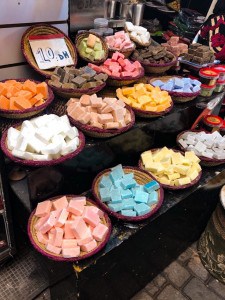
During the treatment, the therapist will apply this soap after soaking you in hot water. They then wash the soap off and exfoliate the skin.
Hammams can be found all over Marrakech. You won’t find it hard to find one to indulge yourself in. The problem will be more which one to choose.
This will probably come down to a combination of things: location, price, and whether you’d prefer to visit a public hammam or experience one in private.
My previous post on this provides more information on the different types that you can choose from.
It also gives you an overview of our experience of a Moroccan hammam at the Hammam de la Rose. This is somewhere we’d definitely recommend and is only a short walk from the main souks.

I have also included some top tips for visiting a hammam in my post so check this out before booking.
If a hammam is something you’d like to experience, you can find some options here.
Escape into Le Jardin Secret (aka the Secret Garden)

This magical oasis can be found tucked away in a hidden corner of the busy market and dates back more than 400 years. Rebuilt in the 19th century, the Secret Garden was only opened to the public in 2016 after extensive restoration work.
As the name suggests, the real attraction here is the Islamic garden, which is fed by an underground irrigation system. There’s also a tower you can climb to get some great views out over the medina. There’s also a boutique, a bookshop and two cafes.
A visit to the Secret Garden is a welcome escape from the hustle and bustle of the souks. It is worth the 60 dirhams to enter (35 dirhams to climb the tower). We ducked in here while wandering the souks and were really glad we did.
If you fancy refreshments nearby but outside of the Secret Garden, literally walk across the street from the garden’s entrance to Café Arabe.
This has a fabulous rooftop terrace where you can sit back and sip on a cocktail while admiring the medina rooftop views. The café also serves food.
Wander around the colourful Majorelle Garden
The Majorelle Garden is a little outside of the main tourist centre (we caught a taxi here). But it’s worth the time spent to get here. It was definitely one of the highlights of our trip.
It’s another complete contrast to the hustle and bustle of other parts of Marrakech. In fact, when you walk into this delightful garden and notice the large cacti, you could be mistaken for thinking you are in Mexico.

The brainchild of French artist Jacques Majorelle, who designed the garden’s layout in the mid-1920s, the Majorelle Garden covers two and half acres. It is home to a breathtaking variety of different flowers and plants.
Gigantic palm trees and cacti rub shoulders with small garden plants and pretty flowers. As you stroll through this beautiful oasis, you’ll also find water features decorated with aquatic plants.
First opened to the public in 1947, the botanical and landscape garden also includes an attractive and vibrantly coloured villa which dates from the 1930s.
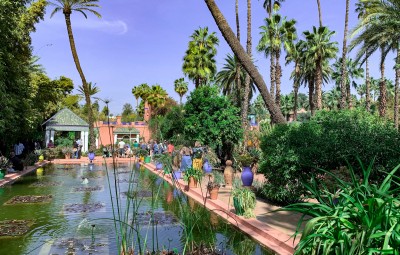
French fashion designers Yves Saint Laurent and Pierre Bergé then restored the garden in the 1980s after purchasing the property.
The grounds have a calming ambience. But it’s worth arriving early to avoid the queues outside. This will also give you the opportunity to capture the beautiful garden without crowds spoiling your photos.
Visitors to the garden can also look around the Islamic Art Museum of Marrakech which showcases Islamic art work.
The museum is housed in Jacques Majorelle’s former workshop. The outside of this is painted an eye-catching blue.

Tickets to visit the garden are 100 dirhams (concessions at 20 dirhams).
Click here for a tour which includes this.
See the Atlas Mountains from the Menara Gardens

We visited the Menara Gardens, which are located on the western edge of Marrakech, after we’d finished exploring the Majorelle Garden.
There was a taxi rank outside the Majorelle Garden and we bartered with a driver on a price to take us there. We assumed he’d drop us off and we’d need to pick up another taxi after visiting. But he waited for us and took us back to the main square.
This was an ideal way to add a detour to the Menara Gardens into our trip whilst ensuring we got back to the main city centre. So this is something you may also want to do.
Established in the 12th century, the main focal point in the Menara Gardens is the large man-made lake and the pavilion.
It is one of the most picturesque sights in Marrakech. And it’s where you’ll get a great view of the Atlas Mountains rising in the distance.

It is very exposed here and it can get very hot. It might therefore be worth coming either early in the morning or later in the afternoon when it’s a little cooler.
Learn about Yves Saint Laurent
Fans of the French designer Yves Saint Laurent may want to spend some time in the intriguing looking building next door to the Majorelle Garden.
This museum is dedicated to the designer and features permanent and temporary exhibitions, a gallery, a research library with over 5,000 volumes, and a 140-seat auditorium. There is also a bookshop and a terrace café.
If you visit the Majorelle Gardens, you can buy a ticket that also gives you access to the museum: opt for the “combined ticket”.
Visit the Saadian Tombs
The Saadian Tombs can be reached via the south side of the Kasbah Mosque on Rue de la Kasbah. They date back to the Saadian dynasty, which ruled Morocco from 1549 to 1659.
Located in a closed garden, the tombs are the final resting place for members of the Saadi royal family. They were sealed off for centuries before the French discovered them in 1917 and opened them up to the public.

We unfortunately didn’t get to visit the tombs, but reviews on TripAdvisor do recommend a trip here.
However, they warn that there is a lack of information in English and the queues can be very long due to tour groups. Visitors are also advised to spend no more than 30 minutes exploring the tombs.
So arrive early if you do want to add this to your itinerary. The tombs are not far from the El Badii Palace so it might be worth coming here first.
The key attraction is the main mausoleum. This houses the graves of the sultan Ahmad al-Mansur and his family in the crypt. Judging by visitor comments on TripAdvisor, a key highlight is the chamber with twelve pillars.
You can book trips to the Saadian Tombs here.
Take afternoon tea at Hotel La Mamounia
This glamorous hotel with its opulent interior is definitely worth visiting.
As a non-resident of the hotel, you can sit out on the veranda at the back and order afternoon tea before taking a stroll around its immaculate Gardens of Enchantment.
A leisurely walk from the Jemaa el-Fna, the Hotel La Mamounia is a stone’s throw from the Koutoubia Mosque.
You’ll need to pass through hotel security and leave your bags. Once through, you walk into the gigantic lobby.
You’ll no doubt be mesmerised by the extravagant interior with its glamourous cocktail bar. However, you’re not allowed to take photos inside so we unfortunately can’t show you this.
Continue through this area and you’ll then come out to a large terrace with steps down to the hotel’s gardens.
According to the hotel’s website, the garden is home to 700 orange trees, 5,000 rose bushes, 21 cactus species, six palm tree species and 200 olive trees.
If you walk beyond the Menzeh Pavilion, you’ll come across the hotel’s vegetable garden. Fresh produce is grown here for the hotel’s kitchens.
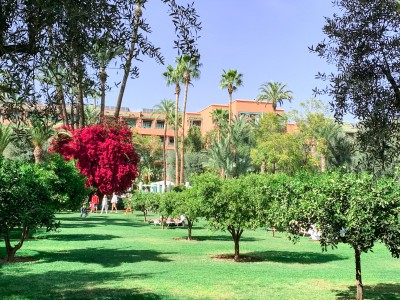
This is another place to head to if you’re looking for some relaxation. And if you have some real cash to splash, you could also stay here!
Experience some traditional Moroccan food
There are different ways you can experience some traditional Moroccan food.
In your riad
If you are staying in a riad, it’s quite likely your hosts will offer you some traditional Moroccan cuisine.
We were served chicken tagine (cooked with lemon and olives) on our first evening. It was one of the best meals we had on our holiday.

In a restaurant
Regardless of whether you’re staying in a riad or not, it’s worth booking a meal in a traditional Moroccan restaurant while you are in Marrakech.
We visited Naranj (more of a Lebanese restaurant) and had a wonderful meal which included lots of small meze dishes and salads.
Some are restaurants housed in former riads and the luxurious surroundings make the meal a unique dining experience (see the section below on where to eat and drink).
We booked Pepe Nero, a massive and stunning restaurant.
We were lucky enough to get a table by the outside pool. It was a really special and romantic experience. And given the quality of food and surroundings, really wasn’t that expensive (although it is pricier than some of the places nearer the medina).
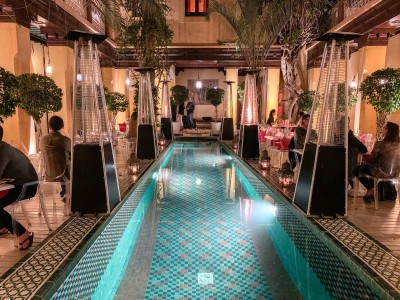
Things to try while in Marrakech include the aforementioned tagine, a Berber dish.
This takes its name from the earthenware pot in which the food is cooked. They are often cooked with meat (for example beef, goat and lamb), but I did try a few vegetarian versions.

There are also lots of dishes with chicken and seafood. And if you like couscous, you’ll love the food here. It is perhaps the most famous feature in Moroccan cuisine.
Bread is also an essential part of daily meals. You should also make sure you try pastry dishes like Pastilla, a Moroccan pie stuffed with different meats or seafood. Or one of their soups or salads.
On a tour
If you would like to sample some traditional food as well as learning a bit more about the cuisine here, there are these tours that include:
See Marrakech’s Bab Agnaou gate
The red sandstone walls that once protected Marrakech’s medina stretch for some 16km and feature multiple entrances.
Bag Agnaou is the most “impressive” of these according to The Culture Trip. Like the rest of the defensive wall, it was built in the 12th century.
Considered the “Royal entrance”, Bab Agnaou is the gateway to the medina’s southern section. It’s not far from the Saadian Tombs, the Kasbah Mosque and the Badii Palace.
If you want to get a decent picture of the Bab Agnaou, you are advised to take it from across the street before you enter the medina quarter.

Visit the Ben Youssef Madrasa and mosque
The Ben Youssef Madrasa takes its name from the neighbouring Ben Youssef Mosque. They can be found north of the souks and not far from the Marrakech Museum.
The mosque is said to be the most important mosque in the city and one of the oldest.
The madrasa was founded in the 14th century as an Islamic school for students who attended this mosque to devote their time to religious education. Apparently it is Morocco’s largest Islamic college and is definitely worth a visit.
Reconstructed in the 16th century, it stopped being used as a college in 1960 and was opened to the public in the early 1980s.
Tourists will be particularly impressed by the madrasa’s spectacular central courtyard. This is based around a large reflective pool.
The madrasa was closed in 2020 due to renovation work so check before visiting.
Take a Moroccan cooking class
As outlined above, Moroccan food is wonderful and extremely varied. So if this has (literally) whetted your appetite, you might want to consider enriching your culinary skills with a cooking class while you are in Marrakech.
You can find a range of classes here.
Taking cooking classes is a great way to meet new people and also discover the riches of Moroccan food first-hand. You’ll also get personal tips from local food experts.
Join one of the Marrakech food tours
If a cooking class isn’t for you, but you want to learn more about the traditions of the country, then there are special Marrakech food tours you can join.
This is a walking tour of Marrakech with tastings; alternatively, you can book this food tour which includes dinner.
This tour takes place at night for anyone pushed for time during the day.
And this tour teaches you how to make the traditional tagine dish.
Pop into the Maison de la Photographie
Opened in 2009, the Photography Museum is located on Rue Souk Ahal Fassi in the medina. It comprises around 8,000 images depicting life in Morocco from 1870 to 1950.
Some of the highlights include photos of the native Berber tribe. According to TripAdvisor, visitors can also see the first colour film recorded in the High Atlas Mountains.
We didn’t manage to visit while we were on our 3 days in Marrakech, but apparently the museum is housed in a traditional riad. This places the historical photographs in an especially unique setting.
As it’s a very small gallery, you could probably fit this museum in while wandering around the medina.
Entry to the museum is 50 Moroccan dirham for adults; anyone under 12 can visit for free.
Learn about Moroccan art in the Dar Si Said Museum
Otherwise known as the Museum of Moroccan Arts, the Dar Si Said Museum is Marrakech’s oldest museum and is a treasure-trove of art works.
Housed in a palace that was once the former home of Si Said (the grand vizier’s brother), the museum is laid out on two floors and is beautifully decorated.
Inside the museum, you’ll find exhibits of Berber culture, including ceramics, jewellery and even musical instruments.
Quite a few websites that you may dip into highlight the stone basin which you’ll come across near the entrance to the museum. Dating back to 1,000 AD, it is an excellent example of Islamic art.
The Dar Si Said Museum is very close to the Bahia Palace and the architecture is quite similar. So it would be interesting and also practical to visit both while you are in the southern part of the medina.
Entry is 70 Moroccan dirhams.
Head to Marrakech’s new town, Gueliz
For those tourists who fancy seeing a different side to the city, head to the modern Gueliz district in Marrakech’s new town.
We didn’t have time to visit but have read that this upmarket neighbourhood is littered with bars, cafes and restaurants which include many famous western outlets.
Avenue Mohammed V is the main centre of activity. It is along this thoroughfare that you’ll also find expensive boutiques and shops. So, if you fancy some shopping away from the souk, this is the place to head to.
Learn about Marrakech’s Jewish heritage on a Mellah walking tour
Some tourists may be interested to explore Marrakech’s Jewish heritage while they are visiting Marrakech. Through this you can see the community’s influence on the city.
You can choose to walk around this fascinating neighbourhood on your own or go with an organised tour. The advantage of taking a tour is that you can find out in detail information on the Mellah’s history and its main landmarks.
Take a trip further afield
You might only have 3 days in Marrakech so want to make the most of the city itself. However, if Marrakech is part of larger trip, then there are options for trips that you can take that are a bit further afield.
You are spoilt for choice with the Atlas Mountains, the Atlantic coast and the desert – all within easy reach. And there are plenty of things to occupy the more intrepid or sporty traveller.
You can also take the train to Casablanca (around 2 hours and 40 minutes away) to explore one of Morocco’s most famous cities.
Maybe visit Casablanca’s Rick’s Cafe, made famous by the film of the same name. Also take in the stunning Hassan II mosque right on the water.
To give you a flavour of the things you can book guided tours for, the options include:
Further information for your 3 days in Marrakech
Marrakech climate and best time of year to visit
The Marrakech climate varies depending on the seasons. At its coldest – in December to January – expect temperatures to hover just under 20 degrees Celsius. This makes it an ideal place for 3 days in Marrakech in the winter.
By contrast, the hottest time of year is July and August. At this time of the year you could be basking in temperatures of close to 40 degrees Celsius.
Because of this, the best time to travel is generally considered to be during the spring and autumn (March to May and September to October). At this time, temperatures are warm, but not stiflingly hot.
The time of year you travel may depend on where else you are going to in Morocco. For example, if you combining Marrakech with an excursion to the High Atlas Mountains, bear in mind that it does get chilly during the winter months.
You also need to be mindful of when Ramadan falls. This important Islamic Festival does affect transport in the country. Because the dates are different each year, it’s worth looking this up before you book your trip so that you can plan accordingly.
How to get to Marrakech
If you are starting your journey in the UK, you can fly directly to Marrakech with a number of airlines. These include British Airways, Royal Air Maroc, EasyJet and Ryanair. European cities are also well served with direct flights from carriers like KLM, Iberia and Lufthansa.
You can fly directly from the US to Morocco but only from New York JFK and with Royal Air Maroc. The six-hour flight is direct to Casablanca and from there the connecting flight to Marrakech takes just under an hour. Another option is fly with Iberia Airlines to Madrid which has regular flights to Marrakech.
Canadians can fly with Air Canada to Casablanca from Montreal and pick up an internal flight. From other Canadian cities, the best option is to fly to London, Madrid or Paris and pick up a connecting flight. Quite a few low-carrier airlines operate services to Marrakech.
How to get from Marrakech airport to the city
Marrakech Menara Airport is 6km from the medina. You can catch a taxi into the city centre but, if you do, make sure you agree the price before setting off as some drivers apparently won’t switch on the meter.
The journey shouldn’t cost you more than round 120 dirhams but it’s best to check costs on the internet before you leave.
The alternative is to book an airport transfer service through your hotel or riad, or to pre-book a transfer.
Although this is more expensive than picking up a taxi when you land, it’s a lot less stressful and also more reassuring if you are arriving in the evening.
We stayed in a riad in the heart of the medina and the advantage of using the airport transfer service is that the driver will walk you to the entrance of your accommodation.
Some of the streets in the medina are so narrow that vehicles cannot access them. When you arrive late at night and are dropped off in the poorly lit streets, having someone guide you to the door is priceless.
What to eat in Marrakech
As mentioned above, we were treated to chicken tagine (cooked with lemon and olives) on our first evening in our riad.
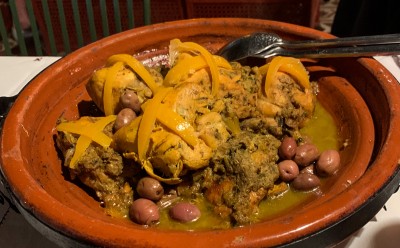
Tagine is a Berber dish, which takes its name from the earthenware pot in which the food is cooked.
Learn how to cook tagine here.
More generally in terms of what to eat in Marrakech, you will find that Moroccan cuisine is very varied and the abundance of spices means that dishes are very flavoursome.
Meat eaters will be spoilt for choice as traditional dishes make use of beef, goat, lamb, chicken and seafood.
As well as tagines, there are lots of dishes with couscous, which is perhaps the most famous feature in Moroccan cuisine. Bread is also an essential part of daily meals.
Morocco grows a large variety of vegetables so also expect to find salads and soups. You can also try pastry dishes like Pastilla, a Moroccan pie stuffed with different meats or seafood.
Morocco also caters for western tastes and French and Italian cuisine can be easily found in many restaurants, particularly in Marrakech’s new town.
What to drink in Marrakech
In terms of drinks, make sure you sample the extremely tasty green tea with mint while you’re in the city. It is arguably Morocco’s most popular drink and watching the waiter demonstrate their pouring technique is worth seeing!
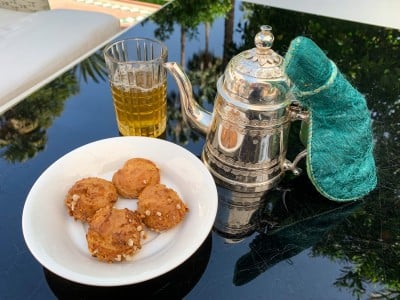
Being a Muslim country, alcohol isn’t widely available (this tended to be the case in the restaurants lining the main square). But there are some restaurants where you can order locally brewed and imported beers as well as wines.
You are advised to order bottled water and you may want to be careful ordering salads if you have a delicate stomach.
Where to eat in Marrakech
The best places to eat and drink in Marrakech are in the medina and the new town. There is a huge range of restaurants to choose from and where you go to eat and drink will depend to a certain extent on where you are staying, how far you want to venture out, what type of dining experience you are after and your budget.
The medina offers some truly authentic Moroccan dining experiences but it’s worth doing some research online either in advance or while you are in Marrakech. In some cases you may want to pre-book as some restaurants are extremely popular.
Suggestions for where to eat in Marrakech
As outlined above, we ate in the Riad Andalla, Pepe Nero and Naranj.
Other places that attract good reviews on Tripadvisor include:
- Ma Maison: an Italian restaurant with pizza, pasta and meat dishes located in the medina.
- Majorelle restaurant: a Moroccan eatery near to the Majorelle Garden. It consistently gets 5 star reviews on Tripadvisor.
- Les Terasses de Jemaa El Fna: located in the heart of the main square, this has a gorgeous roof terrace looking out over the market.
- Café Arabe: This has a fabulous, rooftop terrace where you can sit back and sip on a cocktail while admiring the medina rooftop views. The café also serves food. It is near to The Secret Garden.
Where to stay in Marrakech: further information
If you want an authentic and unforgettable Moroccan experience, then the best area of the city to stay in is the medina in one of the beautifully preserved riads.
Properties that once belonged to wealthy families, many riads have been converted into boutique hotels and usually accommodate up to around 10 bedrooms. They are lavishly decorated and feature a main courtyard, which often include a garden or pool.
Most riads have a rooftop terrace where you’ll be served breakfast. You can also book an optional lunch and dinner (the latter is particularly useful if you are arriving late).
Suggestions for riads to stay in
We stayed in the Riad Andalla and had a wonderful time. Tucked away down a side street on the edge of the medina, it is a beautifully decorated historic building and a perfect place to cool off from the outside heat.
It has lovely bedrooms and its own hammam that you can book in advance.

There is also a huge range of other riads that you can choose from. Some of those that jumped out to me during my research include the following:
- Riad Bindoo: This looks an excellent choice and has a Tripadvisor Certificate of Excellence. Reviews describe the location as “perfect” and “excellent”. It has a rooftop terrace and the décor is beautifully designed in a vibrant blue colour. It has one of the small traditional indoor water pools.
- Riad Charme d’Orient: another lovely place, this is an adults-only riad. It has a traditional water pool and a great rooftop terrace for eating and drinking. It also has deck chairs for sitting in the sun. The bedrooms are beautiful.
- Riad Fabiola: situated in the medina and around a 20-minute stroll to the square, this riad is cheaper than some of the others you might find in searches, so would be ideal if you want to experience a riad without blowing your budget. Despite this, it has a lovely pool in the centre overlooked by huge palm trees, a great roof top terrace and some authentically designed bedrooms.
Other hotels for your 3 days in Marrakech
Alternatively, there are a number of modern hotels, located in the new town and on the fringes of the older part of the city. There are also some high-end hotels in luxurious surroundings. These include:
- The Movenpick Hotel Mansour Eddhani Marrakech: a 5 star hotel, there are three restaurants here, a bar, a spa and wellbeing centre. There are also three heated pools and a kids club, so this would be a perfect place for a family holiday in the winter.
- The Hotel La Mamounia: this is a really high-end hotel in 17 acres of park and just a few minutes from the main square. It is a truly stunning place, but if you can’t afford to stay here, pop in for afternoon tea on the terrace as we did.
- The Sofitel Marrakech Lounge and Spa: There are a range of facilities here, including a Jacuzzi, Turkish bath and gym. There are both indoor and outdoor swimming pools. Along with its restaurants and three bars, the facilities here mean you might never need to leave!
Click here for further ideas for where to stay in Marrakech.
Culture and etiquette
Although Moroccans are followers of the Islamic faith, you will find that, on the whole, Moroccans’ approach to tourists is more open and tolerant than some Muslim countries. Having said that, it’s important to respect people’s religious beliefs and be sensitive to the local culture.
You should therefore dress modestly (i.e. covering arms and upper legs) while you are out exploring. Locals also apparently do not welcome public demonstrations of affection such as kissing and cuddling. Some websites advise tourists not to eat or drink in the street when Ramadan takes place.
If you are not a Muslim, you will not be allowed to enter mosques. In Marrakech, the most important one is the Koutoubia Mosque. Although you won’t be able to gain access, there are plenty of opportunities to take photos of the outside from the surrounding area.
Islamic architecture is spectacular and if you are keen to take photos, there will be plenty of other opportunities to capture Islamic decorations in historic sites. The Bahia Palace mentioned above is one such place where photography is permitted.
As Morocco is a Muslim country, alcohol is not widely available. There are some bars and restaurants in the medina quarter that do serve alcohol but judging by the information available on a number of websites, your best bet is to pick up a taxi and head to Marrakech’s new town.
We were also able to order wine in our riad where we were staying.
Personal safety
Marrakech is generally a safe city, but as with a lot of cities, avoid wandering around poorly lit areas at night and watch your valuables in busy streets and squares. Jemaa el-Fna is a popular area for pickpockets and can get very crowded.
Again, as with most places that you would travel to, we’d advise against carrying a lot of money around with you. Also, be careful when using ATMs as credit card fraud does happen. It’s far better to leave large sums of money in your hotel, many of which will have safes.
Jemaa el-Fna is a good place to change money and there are a couple of places you can go such as Change La Place and Bureau de Change – Chez Ali.
Women travelling on their own or in pairs, should also be mindful that we’ve read that sexual harassment is not uncommon. As you would in other countries where this happens, exercise common sense.
Currency
Morocco’s official currency is the dirham which is made up of 100 santimat. The dirham is a closed currency so you can only buy it once you arrive in the country. At the moment, (the end of 2020), the exchange rate gives you about 12Dh for one pound sterling.
There are cash machines at Marrakech Menara Airport where you can pick up some dirhams before you pick up a taxi or your airport transfer.
You can exchange pound sterling, euros and US dollars for dirhams at the Bureau de Change, at banks and in most hotels.
Is 3 days enough in Marrakech?
We had 3 days in Marrakech and found that this was enough time to see the main sights of the city.
Undoubtedly, if you had 4 days in Marrakech, or even longer, there would be more that you could see and do: there’s no shortage of attractions and sights to occupy your time. This is even more of a case if you factor in taking some day trips outside of the city.
However, if time is limited for you, then 3 days in Marrakech is a perfect period of time. You will get a good feel for the sights and culture of the place – and it will give you a good sense of whether you want to return in the future.
Other ideas for short trips
I hope this has outlined for you the best things to do in Marrakech.
If you’re looking for ideas for other short trips – worldwide and also within Europe – check out some of my other posts. These include:

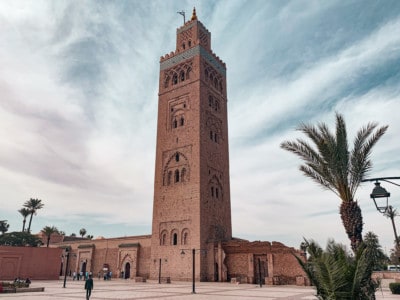
Beautiful article! Thanks for sharing. Morocco is an amazing country.